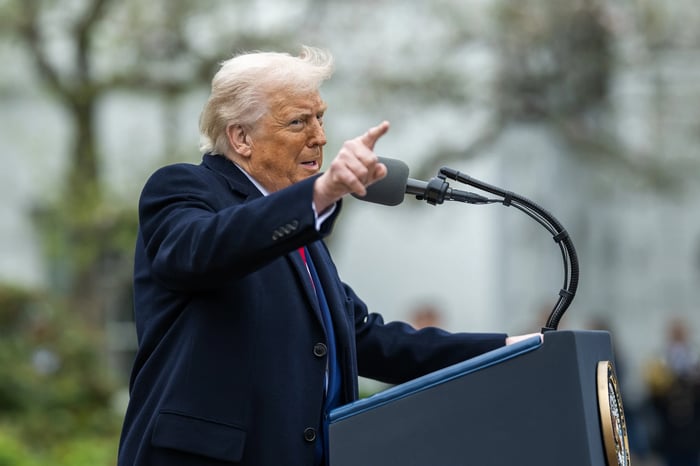The S&P 500 (^GSPC 1.07%) crashed in early April when President Trump announced sweeping tariffs on most countries, but the index bounced back remarkably quickly due to strong earnings growth and economic resilience. With the S&P 500 up 13% in 2025, the index is on track for its the third straight year of double-digit gains, something that has only happened twice since 2000.
However, the picture is less rosy than it appears. Revised jobs data shows hiring slowed sharply over the summer as businesses navigated economic uncertainty, and inflation has trended steadily higher since Trump announced his most severe tariffs in April. Meanwhile, investors just got bad news about the U.S.-China trade war, and it comes at a time when the stock market is already historically expensive.
Here's what you should know.

Image source: Official White House Photo.
Americans (not foreign exporters) are paying the tariffs, and inflation is getting worse
President Trump's tariffs have brought in approximately $195 billion in revenue to date, more than twice the amount collected at the same point last year, so the administration has touted its trade policies as a success. In September, the White House published an article with the headline: President Trump Has Crushed Biden's Inflation Crisis.
The article also quoted Press Secretary Karoline Leavitt. "President Trump has defeated Joe Biden's inflation crisis while successfully implementing powerful tariffs, which haven't hiked prices like the so-called 'experts' claimed." But that statement is simply not true.
CPI inflation has increased in every month since Trump unveiled his most severe tariffs in April. Additionally, while the president has justified his trade policies by saying foreign countries will "pay for the privilege" of doing business in the United States, that statement also rings false. Tariffs are remitted by importers and Americans are bearing the burden.
Goldman Sachs economists report that U.S. businesses and consumers in aggregate will pay 77% of Trump's tariffs in 2025, with consumers alone likely to shoulder more than half the burden. Other experts have similar outlooks. The consensus among 62 economists surveyed by The Wall Street Journal says inflation will keep climbing into next year as companies pass along price increases on more tariffed products.
Renewed trade tensions between the U.S. and China are bad news for the economy
Earlier this month, the Chinese government announced new export restrictions on rare-earth metals used in numerous modern technologies, including everything from semiconductors and smartphones to electric cars and fighter jets. In response, President Trump threatened to apply a 100% tax to Chinese imports in addition to already substantial tariffs.
The renewed tension between the two countries comes at a particularly bad time. Earlier this year, Washington and Beijing called a temporary ceasefire in the trade war, but that truce is set to expire on Nov. 10. Without a long-term trade deal, U.S tariffs on Chinese imports will return to 145%, and Chinese tariffs on U.S. imports will return to 125%.
The situation is bad news for the U.S. economy and stock market because China is the third largest U.S. trade partner by exports and imports, according to the Census Bureau. Supply-chain inefficiencies created by the trade war will inevitably hurt businesses, either by depressing sales because they raise prices, or else by depressing profit margins because they absorb the costs.
David Kelly, chief global strategist at JPMorgan Chase, succinctly summarized the problems with tariffs earlier this year. "They raise prices, slow economic growth, cut profits, increase unemployment, worsen inequality, diminish productivity, and increase global tensions."
The stock market trades at a historically expensive valuation
Unfortunately, bad news about Trump's tariffs has surfaced at a time when the U.S. stock market was already sounding an alarm. The S&P 500 currently trades at 22.4 times forward earnings, an expensive valuation that far exceeds the 10-year average of 18.6 times forward earnings, according to FactSet Research. In fact, the S&P 500 has only achieved a forward price-to-earnings ratio above 22 during two periods in history, and both incidents ended in bear markets.
The first incident was the dot-com bubble. The forward PE ratio drifted above 22 in the late 1990s; but after peaking in March 2000, the S&P 500 declined 49% by October 2002. The second incident was the COVID-19 pandemic. The forward PE ratio shot above 22 in 2020; but after peaking in January 2022, the S&P 500 declined 25% by October 2022.
Here's the big picture: Despite the Trump administration taking a victory lap on its trade policies, inflation has trended higher since the most severe tariffs were announced in April and many economists think consumer prices will keep climbing into 2026. That outcome becomes more likely if renewed tensions between the U.S. and China lead to higher tariffs.
Meanwhile, the S&P 500 trades at an expensive valuation that has historically correlated with bear markets. Of course, drawdowns are inevitable, so you could argue the S&P 500 is always moving toward the next bear market. However, we may get there sooner rather than later due to the precarious state of the economy. So, investors should avoid taking big risks and mentally prepare for a downturn. Hopefully it doesn't happen. But it's always better to be prepared.





